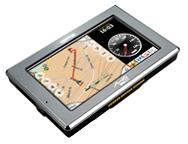Mio Technologies C520 Digital Navigation System
![]()
![]()
![]()
![]()
![]()
![]()
![]()
![]()

People who buy satellite navigation systems to drive around the suburbs might be deluding themselves. Out in the frozen wastes of rural Ontario, a good GPS receiver is almost as important as a good coat.
A good GPS receiver that can tell you where the nearest gas station is defies description.
The Mio C520 is one the nicest of the current generation of satellite navigation devices. It features a large, bright touch panel, an intuitive user interface and – perhaps most importantly – an immense map and location database. It appears to know about every highway, street, road, alley and rutted goat track in North America, with optional maps of Europe to be available shortly.
It can also tell you where things are – lots of things. It can locate gas stations, major shops by name, hospitals, restaurants… there’s every possibility that a list of elephant grooming facilities resides in there somewhere, if you look hard enough.
Based on Windows CE, the user interface of the Mio C520 is unusually easy to work with – the screen is touch sensitive, and you can navigate it with a fingertip. The material the touch screen is made of is particularly well chosen – it’s resistant to scratches, and slightly matted so as not to make the inevitable fingerprints littering its surface too apparent.
The Mio C520 has one moving part – its power switch. Turn the beast on, touch the MioMap icon and it’s good to go. It can display its maps in either two-dimensional or three-dimensional views.
Select where you are and where you want to go and the Mio C520 will find a route to get you there. It will display a list of turns to take, update your location on its map as you proceed and provide you with verbal directions as you drive. It features a better-than-average electronic voice.
The GPS receiver in the Mio C520 is excellent – unlike earlier generations of GPS receivers, which really had to be outside to establish a satellite lock, the Mio C520 can get by with being near a window. It includes a screen to display the number and quality of navigation satellites it has acquired.
The list of features available in the Mio C520 is impressive, and I’m not going to get too deeply into all of them here. Among my favorites are:
- Points of interest: The Find POI screen will let you search for shops and services which exist around your current location. It’s very specific – you can have it locate a nearby Sears or a Best Western hotel, for example. The database of locations that arrived with my Mio C520 appears to be about two years old.
- Speed: The Mio C520 will display your current speed and optionally warn you if you exceed the local speed limits. If you live in an area where the government regards dogmatic traffic policing as a handy adjunct to its other forms of taxation, this could save you more than the price of the GPS receiver the first time you use it. It also maintains a database of traffic cameras.
- Traffic Message Channel support: If you drive in a city with TMC support, you can subscribe to TMC broadcasts to have the Mio C520 guide you around traffic jams and other obstructions. I’ve not had occasion to try this, as the TMC service doesn’t address issues like moose on the road.
- Bluetooth: Bluetooth connectivity allows the Mio C520 to interact with other Bluetooth-enabled devices.
- Music player: The Mio C520 can store MP3 files and play music, replacing a dedicated MP3 player. I have no idea why you’d want it to do this.
- Pictures and videos: You can also store and display still photographs and videos with the Mio C520 – once again, I couldn’t find a reason to do this, although it’s a nice feature to play with if you’re stuck in traffic and you get tired of trying to find the nearest Sears.
- Memory card: The Mio C520 has an SD memory card port in the side, just in case the music and picture features really appeal to you.
The Mio C520 features an internal battery, although it doesn’t run the device for terribly long – a fully charged battery will keep the lights on for about four hours. It’s powered through a USB connector, and can be plugged into an automobile cigarette lighter or a laptop for extended journeys. It comes with a mountable cradle to permanently install it in your ride – I leave mine in one of the cup holders, as it gets used in several vehicles.
If the Mio C520 has any shortcomings, they’re all in its manual. Provided as two PDF files on a CD-ROM rather than a paper reference – based, perhaps, on the assumption that everyone drives around with a laptop in the passenger seat – its instructions were clearly written by someone who knows the device well and can’t imagine its users being less familiar with it. Somewhat poorly organized and difficult to get into, the manuals for the Mio C520 will confront new owners with a steeper learning curve than this otherwise excellent bit of technology deserves.
Despite its deficient instructions, I found the Mio C520 to be among the best of the current GPS systems – to some extent, its largely intuitive user interface makes its documentation superfluous. It has a rich palette of features, and an architecture that will allow you to use as many or as few of them as you like. Its graphics are excellent, and it’s genuinely fun to drive with.
The subtle distinction between an electronic voice that says “turn right in one kilometer” and a passenger who observes “I think you just missed the exit” hardly requires elaboration.